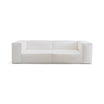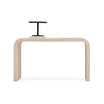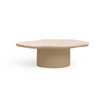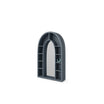-
Inspect the Joints: One of the most important aspects of quality wooden furniture is the strength and durability of its joints. Look for well-constructed joints such as dovetail, mortise and tenon, or dowel joints. These types of joints indicate that the furniture has been skillfully crafted and will stand the test of time.
What are some common types of strong joints found in quality wooden furniture?
-
- Some common types of strong joints found in quality wooden furniture include dovetail joints, mortise and tenon joints, and dowel joints.But the dovetail, mortise and tenon, and tongue and groove are considered the strongest joints. Dovetail joints, often used in drawers, interlock like puzzle pieces for exceptional strength. Mortise and tenon joints connect perpendicular pieces securely, ideal for tables and chairs. Tongue and groove joints are common in panels and offer tight, seamless joints.
-
How can I determine if the joints in a piece of wooden furniture are well-constructed?
- Inspect the joints closely for tight fits, even spacing, and proper glue application. Avoid furniture with weak or poorly executed joints.Well-crafted joints fit tightly with no gaps, show clean edges, and are typically reinforced with glue rather than nails or staples.
-

-
Examine the Finish: A high-quality finish not only enhances the appearance of wooden furniture but also protects it from wear and tear. Look for a smooth, even finish with no rough spots or bubbles. Additionally, a quality finish should be resistant to scratches and stains.
-
: What are some signs of a well-applied finish on wooden furniture?
- A well-applied finish should have a smooth texture, even coloration, and no visible brushstrokes or drips.The finish protects wood from moisture, heat, and wear. Durable finishes like polyurethane or varnish offer long-lasting protection, while oil and wax finishes require regular upkeep. A quality finish should feel smooth and even, without drips, bubbles, or rough patches. To assess durability, check for resistance to light scratches and water—cheap finishes often dull, chip, or stain easily.
- A well-applied finish should have a smooth texture, even coloration, and no visible brushstrokes or drips.The finish protects wood from moisture, heat, and wear. Durable finishes like polyurethane or varnish offer long-lasting protection, while oil and wax finishes require regular upkeep. A quality finish should feel smooth and even, without drips, bubbles, or rough patches. To assess durability, check for resistance to light scratches and water—cheap finishes often dull, chip, or stain easily.
-
: How can I test if a finish is resistant to scratches or stains?
- You can lightly scratch or apply a small amount of liquid (such as water) to an inconspicuous area to see if it damages or stains the finish. However, always ask for permission before conducting such tests.
-

Photo by Taryn Elliott from Pexels:
-
Check for Solid Wood Construction: Solid wood furniture is generally considered to be of higher quality than furniture made from particleboard or veneer. Inspect the piece closely to ensure that it is made entirely from solid wood, rather than having only a thin layer on top.
-
How can I determine if a piece of wooden furniture is made from solid wood? -Look for visible grain patterns, natural variations in color, and consistent material throughout the piece. Solid wood typically shows continuous grain patterns that run through edges and across surfaces. High-quality hardwoods like oak, walnut, and maple are heavier, more durable, and show unique, natural grain patterns that signal authenticity.
-
Are there any specific types of solid wood that are considered higher quality for furniture construction?
- Hardwoods such as oak, maple, cherry, and walnut are commonly used in high-quality wooden furniture due to their durability and attractive appearance.
-

Photo by Kristina Gain from Pexels:
-
Assess the Weight: Quality wooden furniture tends to be heavier due to its solid construction. Heavier furniture often indicates solid wood or dense hardwoods, which are more durable. Lightweight pieces may be made from hollow cores, particleboard, or thin frames. To differentiate between solid and flimsy material, lift or shift it—quality pieces feel substantial, and their weight is evenly distributed. Light, unstable, or wobbly furniture can suggest poor construction or cheap materials.
-
How can I differentiate between solid construction and lightweight materials when assessing the weight of wooden furniture?
- Solid construction will feel substantial and evenly distributed in weight, while lightweight materials may feel hollow or imbalanced.
-
Are there any exceptions where lightweight wooden furniture can still be considered high quality?
- While weight is generally an indicator of quality, certain designs or types of furniture (e.g., minimalist or modern styles) may intentionally use lighter materials without compromising overall quality.
-

Photo by Charlotte May from Pexels:
-
Look for Symmetry: Symmetry reflects precision in manufacturing. Uneven legs, lopsided drawers, or misaligned panels indicate rushed or low-quality craftsmanship. Look especially at doors, drawer fronts, table legs, and panel joins—if parts don’t align properly or one side looks “off,” it can signal poor design or assembly that may affect function and stability over time. Any noticeable asymmetry may indicate poor craftsmanship.
-
What are some common areas where symmetry should be checked in wooden furniture?
- Check for symmetry in drawer alignment, door hinges, hardware placement, and overall balance of the piece.
-
Can minor variations in symmetry be acceptable in high-quality wooden furniture?
- Minor variations may be acceptable due to the natural characteristics of wood, but significant asymmetry or misalignment should be considered a potential quality issue.
-

Photo by Max Rahubovskiy from Pexels:
-
Consider Joinery Techniques: Different joinery techniques can provide insight into the quality of wooden furniture. For example, dovetail joints are known for their strength and durability, while glued or stapled joints may be less reliable over time.
-
What are some common joinery techniques used in quality wooden furniture?
- Common joinery techniques include dovetail joints, mortise and tenon joints, dowel joints, and tongue and groove joints.
-
How can I determine the quality of joinery in a piece of wooden furniture?
- Examine the joints closely for tight fits, even spacing, and proper glue application. Avoid furniture with weak or poorly executed joinery methods.
-

Photo by Max Rahubovskiy from Pexels:
-
Inspect Drawer Construction: Drawers are often a good indicator of overall quality in wooden furniture. Look for sturdy drawer bottoms made from solid wood or plywood rather than flimsy materials like particleboard. Smooth operation and proper alignment are also signs of well-made drawers.
High-quality drawers use dovetail joints, solid wood sides, and wooden or metal glides that slide smoothly without sticking. Drawers should open fully and evenly, without wobbling. If they feel loose, jam easily, or rely solely on staples or glue, it's a red flag for lower craftsmanship.
What materials should I look for in the construction of drawer bottoms?
-
- Solid wood or plywood are preferable materials for drawer bottoms as they offer better strength and durability compared to particleboard or MDF.
-
How can I test the smooth operation of drawers in wooden furniture?
- Open and close the drawers multiple times to ensure they glide smoothly without sticking or wobbling. Pay attention to any signs of misalignment or difficulty in operation.
-
-

Photo by Max Rahubovskiy from Pexels:
-
Check for Kiln-Dried Wood: Kiln-dried wood is less likely to warp or crack over time, making it a desirable feature in quality wooden furniture. Ask the retailer or manufacturer if the wood used in the piece has been kiln-dried.
-
Why is kiln-dried wood considered superior for furniture construction? -Kiln-dried wood has lower moisture content, which reduces the risk of warping, cracking, and shrinking. It provides greater stability and longevity to the furniture.
-
How can I verify if the wood in a piece of furniture has been kiln-dried? -Ask the retailer or manufacturer directly about the kiln-drying process. They should be able to provide information on whether the wood has undergone this treatment.
-

Photo by Max Rahubovskiy from Pexels:
-
Consider the Brand or Manufacturer: Research the reputation and history of the brand or manufacturer of the wooden furniture you are considering. Established brands with a track record of producing high-quality furniture are more likely to deliver on their promises.
-
What are some reputable brands known for producing high-quality wooden furniture?
- Examples of reputable brands known for their quality wooden furniture include Ethan Allen, Stickley, Broyhill, and Thomasville.
-
How can I research the reputation and history of a specific brand or manufacturer? -Look for customer reviews, check their website for information about their craftsmanship and materials used, and seek recommendations from interior designers or woodworking experts.
-
A brand’s reputation often reflects consistency in craftsmanship, material sourcing, and customer service. Look for manufacturers known for using solid hardwood, offering custom joinery, and maintaining ethical or sustainable sourcing. Established brands often provide warranties, detailed construction specs, and transparency in materials—key indicators of trustworthiness and quality.

Photo by Curtis Adams from Pexels:
-
Read Reviews and Seek Recommendations: Before making a purchase, read customer reviews and seek recommendations from friends, family, or online communities. This can provide valuable insights into the quality and durability of specific wooden furniture pieces.
-
Where can I find reliable customer reviews for wooden furniture?
- Look for reputable websites that specialize in furniture reviews such as Consumer Reports or visit online marketplaces like Amazon where customers often leave feedback.
- Customer reviews reveal real-world performance, highlighting issues like durability, ease of assembly, finish quality, and how furniture holds up over time. Look for recurring comments—both positive and negative—as they often point to consistent trends.
-
How can seeking recommendations help me in finding quality wooden furniture?
- Recommendations from people who have already purchased wooden furniture can provide firsthand experiences and insights into the quality, durability, and overall satisfaction with specific brands or pieces.
-
Remember, these tips are meant to serve as a general guide when checking the quality of wooden furniture. For more detailed information and expert advice, visit credible sources such as Klekktic, which specializes in providing information on quality furniture and woodworking techniques.

Photo by Curtis Adams from Pexels:
| Ways to Tell the Quality of Wood Furniture |
|---|
| 1. Inspect the Joints |
| 2. Examine the Finish |
| 3. Check for Solid Wood Construction |
| 4. Assess the Weight |
| 5. Look for Symmetry |
| 6. Consider Joinery Techniques |
| 7. Inspect Drawer Construction |
| 8. Check for Kiln-Dried Wood |
| 9. Consider the Brand or Manufacturer |
| 10. Read Reviews and Seek Recommendations |
FAQ
What are some common types of strong joints found in quality wooden furniture?
Some common types of strong joints found in quality wooden furniture include dovetail joints, mortise and tenon joints, and dowel joints.
How can I determine if the joints in a piece of wooden furniture are well-constructed?
Inspect the joints closely for tight fits, even spacing, and proper glue application. Avoid furniture with weak or poorly executed joints.
What are some signs of a well-applied finish on wooden furniture?
A well-applied finish should have a smooth texture, even coloration, and no visible brushstrokes or drips.
How can I test if a finish is resistant to scratches or stains?
You can lightly scratch or apply a small amount of liquid (such as water) to an inconspicuous area to see if it damages or stains the finish. However, always ask for permission before conducting such tests.
How can I determine if a piece of wooden furniture is made from solid wood?
Look for visible grain patterns, natural variations in color, and consistent material throughout the piece. Solid wood furniture will not have a veneer or particleboard layer.
How can I differentiate between solid construction and lightweight materials when assessing the weight of wooden furniture?
Solid construction will feel substantial and evenly distributed in weight, while lightweight materials may feel hollow or imbalanced.
What materials should I look for in the construction of drawer bottoms?
Solid wood or plywood are preferable materials for drawer bottoms as they offer better strength and durability compared to particleboard or MDF.













